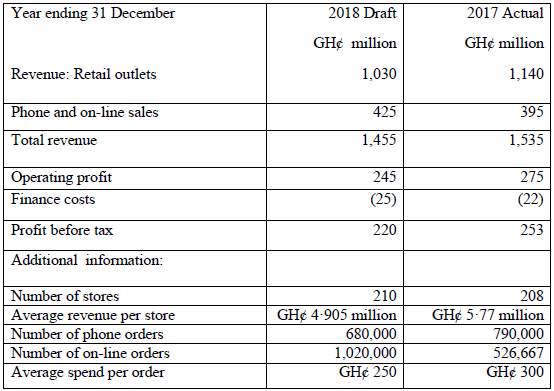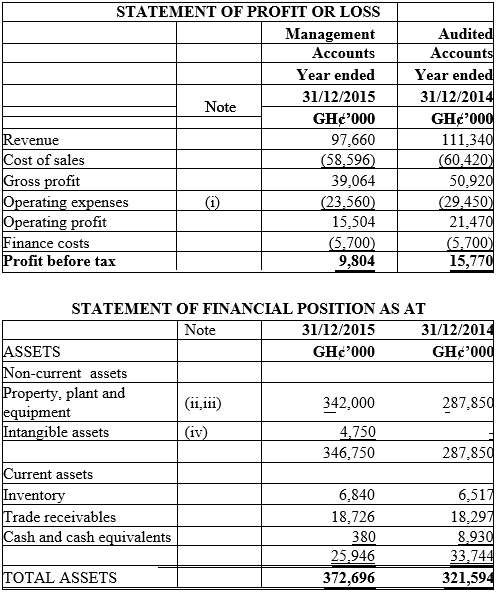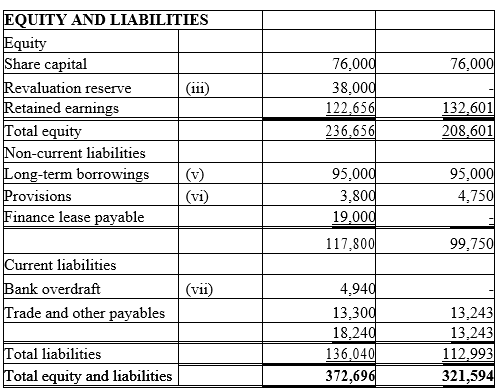Nov 2020 Q2 a.
You were recently employed by AD Chartered Accountants as a Manager. You are currently preparing the planning memorandum for your client, Manuf Co., a manufacturer of machinery used in the bauxite extraction industry. The Company is a member of the Manufacturing Association of Ghana and has won several awards for manufacturing environmentally friendly products. You are also planning the audit of the financial statements for the year ended 31 March 2019. The draft financial statements show revenue of GH¢100 million (2018 – GH¢50 million), profit before tax of GH¢1 million (2018 – GH¢0.5 million) and total assets of GH¢200 million (2018 – GH¢150 million). Your firm was appointed as auditor to Manuf Co. for the first time in October 2018.
Below is an extract of the business operation and development of Manuf Co:
One of the key customers, Law Co Ltd, communicated in January 2019, via its lawyers with Manuf Co., claiming damages for injuries suffered by a drilling machine operator whose arm was severely injured when a machine malfunctioned. Odo Pa Nye, the Chief Executive Officer of Manuf Co., has told you that the claim is being ignored as it is generally known that Law Co Ltd has a poor health and safety record, and thus the accident was their fault. Two orders which were placed by Law Co Ltd in February 2019 have been cancelled.
All machines are supplied carrying a one year warranty. A warranty provision is recognised on the balance sheet as GH¢2.5 million (2018 – GH¢ 2.4 million). Odo Pa Nye estimates the cost of repairing defective machinery reported by customers, and this estimate forms the basis of the provision.
Work in progress is valued at GH¢ 15 million as at 31 March 2019. A physical inventory count was held on 23 March 2019. The Chief Engineer estimated the stage of completion of each machine at that date. One of the major components included in the bauxite extracting machinery is now being sourced from overseas. The new supplier, Osoro Co., is located in Germany and invoices Manuf Co in euros. There is a trade payable of GH¢ 1.5 million owing to Osoro Co. recorded within current liabilities.
Manuf Co. designs, constructs and installs machinery for three key customers. Payment is due in three instalments: 70% is due when the order is confirmed (stage one), 15% on delivery of the machinery (stage two), and 15% on successful installation in the customer’s bauxite mine (stage three). Generally it takes four months from the order being confirmed until the final installation.
At 31 March 2019, there was an amount outstanding of GH¢1.5 million from Mmere Pa Nye Company Ltd which was in dispute. Mmere Pa Nye Company Ltd is refusing to pay until the machinery, which was installed in August 2017, is running at 100% efficiency.
Odo Pa Nye owns 60% of the shares in Manuf Co. She also owns 55% of Pacific Co., which leases a head office to Manuf Co. Odo Pa Nye is considering selling some of her shares in Manuf Co. in late January 2019, and would like the audit to be finished by that time.
Required:
a) Using the information provided, identify and explain the significant audit risks, and any other matters to be considered when planning the final audit for Manuf Co. for the year ended 31 March 2019. (15 marks)
View Solution
Principal Audit Risks of Manuf Co
Legal claim
The claim should be investigated seriously by Manuf Co. The chief executive officer’s (CEO) opinion that the claim will not result in any financial consequence for Manuf Co is naïve and flippant. Damages could be awarded against Manuf Co if it is found that the machinery is faulty. The recurring high level of warranty provision implies that machinery faults are fairly common and therefore the accident could be the result of a defective machine being supplied to Law Co Ltd. The risk is that no provision is created for the potential damages under IAS 37 Provisions, Contingent Liabilities and Contingent Assets, if the likelihood of paying damages is considered probable. Alternatively, if the likelihood of damages being paid to Law Co Ltd is considered a possibility then a disclosure note should be made in the financial statements describing the nature and possible financial effect of the contingent liability. As discussed below, the CEO, Odo Pa Nye, has an incentive not to make a provision or disclose a contingent liability due to the planned share sale post year end.
A further risk is that any legal fees associated with the claim have not been accrued within the financial statements. As the claim has arisen during the year, the expense must be included in this year’s income statement, even if the claim is still on- going at the year end.
The fact that the legal claim is effectively being ignored may cast doubts on the overall integrity of senior management, and on the integrity of the financial statements. Management representations should be approached with a degree of professional scepticism during the audit.
Law Co Ltd has cancelled two orders. If the amounts are still outstanding at the year end then it is highly likely that Law Co Ltd will not pay the invoiced amounts, and thus receivables are overstated. If the stage one payments have already been made, then
Law Co Ltd may claim a refund, in which case a provision should be made to repay the amount, or a contingent liability disclosed in a note to the financial statements.
Law Co Ltd is one of only five major customers, and losing this customer could have future going concern implications for Manuf Co if a new source of revenue cannot be found to replace the lost income stream from Law Co Ltd. If the legal claim becomes public knowledge, and if Manuf Co is found to have supplied faulty machinery, then it will be difficult to attract new customers.
A case of this nature could bring bad publicity to Manuf Co, a potential going concern issue if it results in any of the five key customers terminating orders with Manuf Co. The auditors should plan to extend the going concern work programme to incorporate the issues noted above.
Warranty provision
The warranty provision is material at 2·6% of total assets (2018 – 2·7%). The provision has increased by only GHS 100,000, an increase of 4·2%, compared to a revenue increase of 21·4%. This could indicate an underprovision as the percentage change in revenue would be expected to be in line with the percentage change in the warranty provision, unless significant improvements had been made to the quality of machines installed for customers during the year. This appears unlikely given the legal claim by Law Co Ltd, and the machines installed at Mmere Pa Nye Company Ltd operating inefficiently. The basis of the estimate could be understated to avoid charging the increase in the provision as an expense through the income statement. This is of special concern given that it is the CEO and majority shareholder who estimates the warranty provision.
Inventories
Work in progress is material to the financial statements, representing 8·9% of total assets. The inventory count was held two weeks prior to the year end. There is an inherent risk that the valuation has not been correctly rolled forward to a year end position.
The key risk is the estimation of the stage of completion of work in progress. This is subjective, and knowledge appears to be confined to the chief engineer. Inventory could be overvalued if the machines are assessed to be more complete than they actually are at the year end. Absorption of labour costs and overheads into each machine is a complex calculation and must be done consistently with previous years.
It will also be important that consumable inventories not yet utilised on a machine, e.g. screws, nuts and bolts, are correctly valued and included as inventories of raw materials within current assets.
Overseas supplier
As the supplier is new, controls may not yet have been established over the recording of foreign currency transactions. Inherent risk is high as the trade payable should be retranslated using the year end exchange rate per IAS 21 The Effects of Changes in Foreign Exchange Rates. If the retranslation is not performed at the year end, the trade payable could be significantly over or under valued, depending on the movement of the dollar to euro exchange rate between the purchase date and the year end. The components should remain at historic cost within inventory valuation and should not be retranslated at the year end.
Revenue Recognition – timing
Manuf Co raises sales invoices in three stages. There is potential for breach of IFRS 15 Revenue from Contract with Customers.
The core principle of IFRS 15 is that an entity will recognise revenue to depict the transfer of promised goods or services to customers in an amount that reflects the consideration to which the entity expects to be entitled in exchange for those goods or services. This core principle is delivered in a five-step model framework.
- Identify the contract(s) with a customer
- Identify the performance obligations in the contract
- Determine the transaction price
- Allocate the transaction price to the performance obligations in the contract
- Recognise revenue when (or as) the entity satisfies a performance obligation.
These steps ensure revenue should only be recognised once the seller has the right to receive it, in other words the seller has performed its contractual obligations. This right does not necessarily correspond to amounts falling due for payment in accordance with an invoice schedule agreed with a customer as part of a contract. Manuf Co appears to receive payment from its customers in advance of performing any obligation, as the stage one invoice is raised when an order is confirmed i.e. before any work has actually taken place. This creates the potential for revenue to be recognised too early, in advance of any performance of contractual obligation. When a payment is received in advance of performance, a liability should be recognised equal to the amount received, representing the obligation under the contract. Therefore a significant risk is that revenue is overstated and liabilities understated.
Disputed receivable
The amount owed to Mmere Pa Nye Company Ltd is highly material as it represents 50·9% of profit before tax, 2·3% of revenue, and 3% of total assets. The risk is that the receivable is overstated if no impairment of the disputed receivable is recognised.
Majority shareholder
Odo Pa Nye exerts control over Manuf Co via a majority shareholding, and by holding the position of CEO. This greatly increases the inherent risk that the financial statements could be deliberately misstated, i.e. overvaluation of assets, undervaluation of liabilities, and thus overstatement of profits. The risk is severe at this year end as Odo Pa Nye is hoping to sell some Manuf Co shares post year end. As the price that she receives for these shares will be to a large extent influenced by the financial position of the company at 31 March 2019, she has a definite interest in manipulating the financial statements for her own personal benefit. For example:
- Not recognising a provision or contingent liability for the legal claim from Law Co Ltd
- Not providing for the potentially irrecoverable receivable from Jacks Mines Co
- Not increasing the warranty provision
- Recognising revenue earlier than permitted by IFRS 15 Revenue from Contract with Customers
Related party transactions
Odo Pa Nye controls Manuf Co and also controls Pacific Co. Transactions between the two companies should be disclosed per IAS 24 Related Party Disclosures. There is risk that not all transactions have been disclosed, or that a transaction has been disclosed at an inappropriate value. Details of the lease contract between the two companies should be disclosed within a note to the financial statements, in particular, any amounts owed from Manuf Co to Pacific Co at 31st December, 2019 should be disclosed.
Other issues
- Odo Pa Nye wants the audit to be completed as soon as possible, which brings forward the deadline for completion of the audit. The audit team may not have time to complete all necessary procedures, or there may not be time for adequate reviews to be carried out on the work performed. Detection risk, and thus audit risk is increased, and the overall quality of the audit could be jeopardised.
- This is especially important given that this is the first year audit and therefore the audit team will be working with a steep learning curve. Audit procedures may take longer than originally planned, yet there is little time to extend procedures where necessary.
- Odo Pa Nye may also exert considerable influence on the members of the audit team to ensure that the financial statements show the best possible position of Manuf Co in view of her share sale. It is crucial that the audit team members adhere strictly to ethical guidelines and that independence is beyond question.
- Due to the seriousness of the matters noted above, a final matter to be considered at the planning stage is that a second partner review (Engagement Quality Control Review) should be considered for the audit this year end. A suitable independent reviewer should be indentified, and time planned and budgeted for at the end of the assignment.
Conclusion
From the range of issues discussed in these briefing notes, it can be seen that the audit of Manuf Co will be a relatively high risk engagement. (15 marks)



